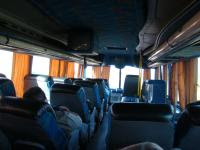On our last day in Malargüe we repeated last year's trek to the dam on the nearby Malargüe River, 8 km from the hostel, only we set off in the morning, as early as we could manage to get up, after a delicious breakfast of home-made bread and jam. We took a more direct route, so we arrived earlier, but then we spent a lot of time leisurely lying on the grass and sipping mate.
On our way back to the hostel (in fact, right before the entrance gate), we found an overflowing irrigation ditch and had to walk on the little wall that formed the edge of the bridge crossing the ditch. By lack of attention or sheer bad luck, I stepped on the wrong spot and found my right leg sinking into the cold water of the ditch along with half of my body. The other leg must have slipped somehow, though not before my left knee hit the concrete edge. I cried out for help, and my two friends promptly lifted me up. Though I was soaked from the waist down, the water was clear and my backpack got only slightly wet in the bottom. My wallet was miraculously spared, as was the bag with my camera in it. But my knee hurt so much I couldn't stand or walk.
After the initial pain subsided, I managed to stand on my feet, supported on both sides by my pals, and step by step get into the hostel. Once in my room, I changed my clothes and surveyed the damage. I got a few bleeding scrapes and bruises, nothing serious. But the knee was hurting badly, and I was devastated — I thought I'd broken something and this was the end of my vacations.
In the end, I took a Diclofenac pill from one my friends, and plopped into bed for a nap. I felt much relieved (and less desperate) when I woke up.
In the late afternoon we took a cab to the city in order to visit the seat of the Pierre Auger Observatory, which is the largest cosmic ray observatory in the world (about 1,500 high-energy particle detectors spread over 3,000 km² in the southern Mendoza desert). We heard a lecture explaining their work and their latest findings.
(We tried to get into that lecture when we went to Malargüe in 2007, but the facilities had been overwhelmed by a troop of about 20 nuns.) After the observatory, we walked around town looking for places to restock our cooking supplies. We got noodles, rice, oil, some non-perishable vegetables, and a few other things we needed. My knee bothered me all this time, but I could follow, if only at a slow pace.
We had bus tickets for San Rafael, and from there to Neuquén, booked in advance. The next day we left Malargüe.










 This area was formerly under the sea. The waters covered all of what today is northern Patagonia, which is why you can found
This area was formerly under the sea. The waters covered all of what today is northern Patagonia, which is why you can found  The soil, as you can see, has several different colours. They correspond to different compositions of lava and ejecta from the volcanoes. None of them is truly inactive, but I gathered the last eruptions took place millennia ago. Today the visitor walks on a mixture of small porous stones and lava ground to dust, plus
The soil, as you can see, has several different colours. They correspond to different compositions of lava and ejecta from the volcanoes. None of them is truly inactive, but I gathered the last eruptions took place millennia ago. Today the visitor walks on a mixture of small porous stones and lava ground to dust, plus  The wind blows all the time with great force — the typical strong Patagonian wind at ground level, and a extremely potent wind when you climb the volcanic hills (our guide took us to a fairly low hill and told us to crawl, not stand up, once we reached the top, since a gust of wind over 100 km/h might easily send a person flying and falling down the volcanic cone). Almost nothing lives here besides a few hardy species of plants, and
The wind blows all the time with great force — the typical strong Patagonian wind at ground level, and a extremely potent wind when you climb the volcanic hills (our guide took us to a fairly low hill and told us to crawl, not stand up, once we reached the top, since a gust of wind over 100 km/h might easily send a person flying and falling down the volcanic cone). Almost nothing lives here besides a few hardy species of plants, and 



 Here I am! After a
Here I am! After a 












